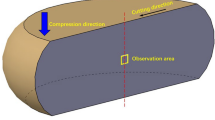Abstract
The hot deformation behavior of a biomedical β-type Ti-Nb-Ta-Zr alloy has been studied through applying hot compression tests over a wide range of temperatures and strain rates (600-900 °C and 0.003-0.3 s−1). The main microstructural feature of the specimens, which were deformed at 900 °C, is the pancaked primary grains decorated by the serrated boundaries. The latter may well imply to the occurrence of dynamic recovery. The dynamic recrystallization however is considered as the main restoration mechanism in the specimens, which were deformed at 800 °C under all strain rates. The sizes of the new recrystallized grains well follow the serration amplitude of the primary grain boundaries. At lower deformation temperatures (600 and 700 °C), the strain rate sensitivity is suddenly decreased and ended to the strain localization in the form of macro shear band. The higher accumulated energy within the shear band zones appears to stimulate the occurrence of dynamic recrystallization. To further clarify the high-temperature flow behavior of the experimental alloy, a quantitative approach has been also employed. The observed flow hardening and softening has been justified considering the evolved microstructural features.













Similar content being viewed by others
References
K. Wang, The Use of Titanium for Medical Applications in the USA, Mater. Sci. Eng. A, 1996, 213, p 134–137
M. Long and H. Rack, Titanium Alloys in Total Joint Replacement—A Materials Science Perspective, Biomaterials, 1998, 19, p 1621–1639
Duan Y-P, P. Li, K.-M. Xue, Q. Zhang, and X.-X. Wang, Flow Behavior and Microstructure Evolution of TB8 Alloy During Hot Deformation Process, Trans. Nonferr. Met. Soc. China, 2007, 17, p 1199–1204
R. Banerjee, S. Nag, and H. Fraser, A Novel Combinatorial Approach to the Development of Beta Titanium Alloys for Orthopaedic Implants, Mater. Sci. Eng. C, 2005, 25, p 282–289
D. Kuroda, M. Niinomi, M. Morinaga, Y. Kato, and T. Yashiro, Design and Mechanical Properties of New β Type Titanium Alloys for Implant Materials, Mater. Sci. Eng. A, 1998, 243, p 244–249
S. Hanada and O. Izumi, Transmission Electron Microscopic Observations of Mechanical Twinning in Metastable Beta Titanium Alloys, Metall. Trans. A, 1986, 17, p 1409–1420
M. Oka and Y. Taniguchi, {332} Deformation Twins in a Ti-15.5 pct V Alloy, Metall. Mater. Trans. A, 1979, 10, p 651–653
E. Bertrand, P. Castany, I. Péron, and T. Gloriant, Twinning System Selection in a Metastable β-Titanium Alloy by Schmid Factor Analysis, Scr. Mater., 2011, 64, p 1110–1113
H. Yilmazer, M. Niinomi, M. Nakai, K. Cho, J. Hieda, Y. Todaka et al., Mechanical Properties of a Medical β-Type Titanium Alloy with Specific Microstructural Evolution Through High-Pressure Torsion, Mater. Sci. Eng. C, 2013, 33, p 2499–2507
E. Farghadany, A. Zarei-Hanzaki, H. Abedi, D. Dietrich, M. Yadegari, and T. Lampke, The Coupled Temperature-Strain Rate Sensitivity of Ti-29Nb-13Ta-4.6 Zr Alloy, Mater. Sci. Eng. A, 2014, 610, p 258–262
E. Farghadany, A. Zarei-Hanzaki, H. Abedi, D. Dietrich, and T. Lampke, The Strain Accommodation in Ti–28Nb–12Ta–5Zr Alloy During Warm Deformation, Mater. Sci. Eng. A, 2014, 592, p 57–63
V. Balasubrahmanyam and Y. Prasad, Hot Deformation Mechanisms in Metastable Beta Titanium Alloy Ti–10V–2Fe–3Al, Mater. Sci. Technol., 2001, 17, p 1222–1228
V. Balasubrahmanyam and Y. Prasad, Deformation Behaviour of Beta Titanium Alloy Ti–10V–4.5Fe–1.5Al in Hot Upset Forging, Mater. Sci. Eng. A, 2002, 336, p 150–158
I. Weiss and S. Semiatin, Thermomechanical Processing of Beta Titanium Alloys—An Overview, Mater. Sci. Eng. A, 1998, 243, p 46–65
W.-S. Lee, C.-F. Lin, T.-H. Chen, and H.-H. Hwang, Correlation of Dynamic Impact Properties with Adiabatic Shear Banding Behaviour in Ti–15Mo–5Zr–3Al Alloy, Mater. Sci. Eng. A, 2008, 475, p 172–184
B. Dodd, Adiabatic Shear Localization: Occurrence, Theories, and Applications, Pergamon Press, Oxford, 1992
M.N. Bassim, Study of the Formation of Adiabatic Shear Bands in Steels, J. Mater. Process. Technol., 2001, 119, p 234–236
L. Qiang, X. Yongbo, and M. Bassim, Dynamic Mechanical Properties in Relation to Adiabatic Shear Band Formation in Titanium Alloy-Ti17, Mater. Sci. Eng. A, 2003, 358, p 128–133
A.K. Zurek, The Study of Adiabatic Shear Band Instability in a Pearlitic 4340 Steel Using a Dynamic Punch Test, Metall. Mater. Trans. A, 1994, 25, p 2483–2489
K. Hartley, J. Duffy, and R. Hawley, Measurement of the Temperature Profile During Shear Band Formation in Steels Deforming at High Strain Rates, J. Mech. Phys. Solids, 1987, 35, p 283–301
O. Karasevskaya, O. Ivasishin, S. Semiatin, and Y.V. Matviychuk, Deformation Behavior of Beta-Titanium Alloys, Mater. Sci. Eng. A, 2003, 354, p 121–132
A. Galiyev, R. Kaibyshev, and G. Gottstein, Correlation of Plastic Deformation and Dynamic Recrystallization in Magnesium Alloy ZK60, Acta Mater., 2001, 49, p 1199–1207
Y. Nakayama and K. Morii, Microstructure and Shear Band Formation in Rolled Single Crystals of Al Mg Alloy, Acta Metall., 1987, 35, p 1747–1755
O. Senkov, B. Chakoumakos, J. Jonas, and F. Froes, Effect of Temperature and Hydrogen Concentration on the Lattice Parameter of Beta Titanium, Mater. Res. Bull., 2001, 36, p 1431–1440
M. Barnett, G. Kelly, and P. Hodgson, Predicting the Critical Strain for Dynamic Recrystallization Using the Kinetics of Static Recrystallization, Scr. Mater., 2000, 43, p 365–369
Wang Z-J, H.-F. Qiang, X.-R. Wang, and G. Wang, Constitutive Model for a New Kind of Metastable β Titanium Alloy During Hot Deformation, Trans. Nonferr. Met. Soc. China., 2012, 22, p 634–641
Author information
Authors and Affiliations
Corresponding author
Rights and permissions
About this article
Cite this article
Ghanbari, E., Zarei-Hanzaki, A., Farghadany, E. et al. High-Temperature Deformation Characteristics of a β-Type Ti-29Nb-13Ta-4.6Zr Alloy. J. of Materi Eng and Perform 25, 1554–1561 (2016). https://doi.org/10.1007/s11665-016-1953-3
Received:
Revised:
Published:
Issue Date:
DOI: https://doi.org/10.1007/s11665-016-1953-3




